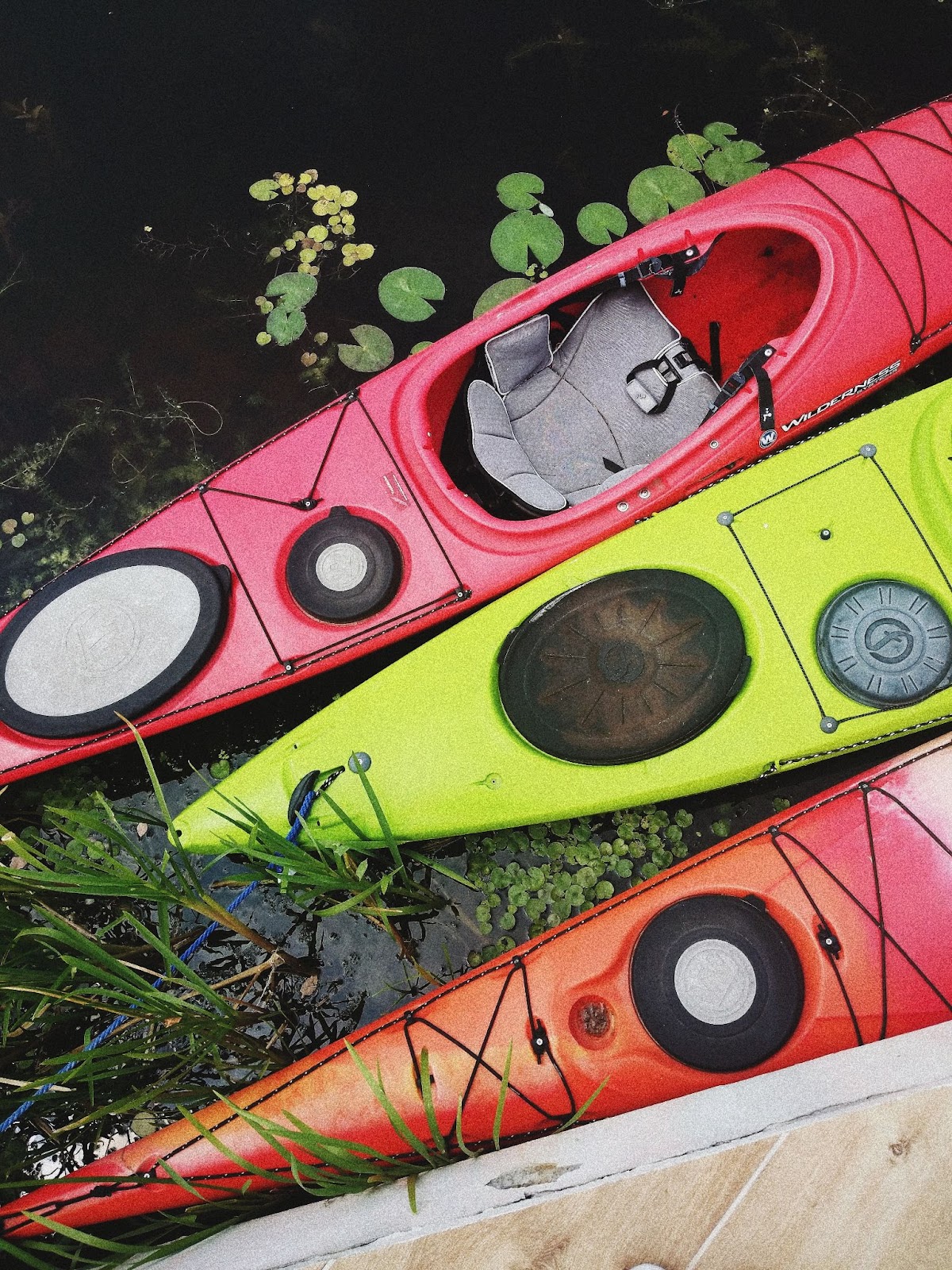Kayaking can be an extremely enjoyable and rewarding activity, but did you know that it can also serve as a great form of exercise?
Kayaking can be a great way to get in some low intensity exercise while taking in the beautiful surroundings of wherever you may be out on the water. But the question remains, how many calories can you burn while kayaking? Let’s get into the details and find out.
What is Kayaking?
Kayaking is an incredibly fun and enjoyable activity that is also extremely good for your physical and mental health. Whether you prefer to kayak in a pool, on a lake, or down a river, it’s an excellent way to get outdoors, explore nature, and stay fit.
But what exactly is kayaking? It’s an outdoor watersport where you use a paddle to maneuver a boat through the water – usually in the form of a single-person vessel called a kayak. Kayaks come in many shapes and sizes depending on the type of water you plan to be paddling through. For example, whitewater kayaks are designed slightly differently than recreational or touring ones that are made with improved tracking techniques.
No matter the type of kayak though, they all require some level of physical strength which makes it not only fun but also rewarding exercise! So does kayaking burn calories? The answer is yes – quite effectively too! Depending on your size and intensity level, you can expect to burn between 300-600 calories in an hour when paddling at normal speed in medium difficulty waters. This makes it an ideal way to stay fit or just keep active during leisure time.
Benefits of Kayaking
In addition to being an enjoyable and accessible outdoor activity, Kayaking can also have a positive effect on physical and mental health. With the proper technique and gear, kayakers can burn calories, reduce stress levels, and get some much-needed exercise. The number of calories burned while kayaking depends on various factors such as paddling intensity, the kayakers’ weight and duration of time spent out on the water. A 180-pound person who spends an hour in a moderate intensity of kayaking can burn up to 400 calories. In comparison to swimming or running, Kayaking expends around half as many calories per hour. However, it’s more intensive than activities like biking or hiking. Anglers may also be able to reap extra caloric burn rewards if they’re hauling gear during their trip in addition to paddling. Kayaking is considered an enjoyable low-impact exercise that’s suitable for people at different fitness levels so long as proper form is maintained throughout the session. As well as allowing users to explore tranquil waterways and streams, it provides full body strength training which can tone muscles around the torso, back and arms. It also requires balance which improves steadiness and coordination in other aspects of life too.
For those who find themselves often stressed or anxious due to work/life balance or other life circumstances; kayaking could be a great way for them to take a break from their everyday lives by exploring new areas of nature – thus providing them with great mental relaxation from the daily hustle & bustle of life!
Does Kayaking Burn Calories
Kayaking provides a variety of physical and mental benefits. It is a fun and challenging workout that can help you stay fit and healthy. With this in mind, many people are curious to know if kayaking can help you burn calories. In this article, we will be looking at the answer to this question and discussing the benefits of kayaking for calorie burning.
Factors That Affect Calorie Burning
Calorie burning while kayaking is determined by a number of different factors. These include the intensity of the paddling, how long you stay on the water and your body composition. The higher the intensity and longer you stay out on the water, then the more calories you will burn. Fitness level, health and body composition are also important considerations that can affect your calorie burning rate. The amount of calories burned during kayaking largely depends on your exertion level and habits. Even when paddling at a leisurely pace, you will still be able to burn some calories as long as you are moving consistently in the water. If you challenge yourself to paddle faster or use more powerful strokes, then you will naturally burn more calories at a higher rate.
Your bodyweight also plays a major role in how many calories are being burned. As such, heavier individuals need to paddle harder to burn an equivalent number of calories as those with lighter bodies require less effort to reach their target goal. It’s best to focus on improving your efficiency with each boat ride so that even if you don’t shift too much weight around while paddling, your body eventually learns how to effectively use its energy reserves for optimal performance or calorie burning out in on the water!
How Many Calories Can You Burn with kayaking?
Kayaking is a great way to burn calories while having fun in the sun. The exact number of calories burnt while kayaking will depend on many factors, such as your weight, the pace at which you paddle, and the duration of your session. However, it is estimated that an hour of leisurely kayaking can burn up to 300 calories for a person weighing 154 pounds. For those looking to get more intense workout with their kayak, you can also up your calorie-burn by engaging in more strenuous paddling activities. For instance, fitness paddling can feature faster speeds, higher duration and frequent changes in direction; by doing so, it is estimated that a person weighing 154 pounds could burn up to 600 calories per hour! In other words, if you increase the effort with which you paddle, you can boost the calorie-burning benefits of kayaking almost double! Additionally, strength training exercises involving your arms and core muscles will help you build upper body power and increase calorie burning as well. No matter how often or intensely you choose to kayak—whether it’s only once in a while or regularly throughout the year—you can significantly increase the number of calories burned with this enjoyable activity.
Other Benefits of Kayaking
Kayaking offers more than calorie burning benefits. Although kayaking is an excellent low impact exercise, it also has a variety of other benefits, such as increased mental and physical strength, improved motor skills and balance, and the experience of being in nature. Let’s take a look at some of the other side benefits of this popular watersport.
Improved Cardiovascular Health
Kayaking is an excellent way to improve cardiovascular health. By continuously paddling, your heart rate rises and the muscles of your upper body, core, and legs are engaged. This type of exercise increases your heart rate to an aerobic level, meaning that your body is taking in enough oxygen for it to be used for energy. When kayaking at a moderate intensity level, you will be able to greatly improve your cardiovascular strength and endurance. Regularly kayaking can strengthen the circulatory system as well as lower resting heart rate and lower blood pressure levels.
In addition, you’ll experience improved physical stamina and increased muscular strength throughout your upper body, core and lower body muscles due to the constant need for balance and stability while kayaking.
Improved Muscular Strength
Muscular strength is improved with kayaking because it exercises both the upper and lower body muscles. The arm muscles used to propel the kayak are involved in propulsion as well as paddling, while your core muscles stabilize the body against the rocking of wavy waters. The same muscles are also employed when you’re lifting and carrying a loaded kayak. Most paddlers find that after a few hours of paddling they gain increased strength and endurance resulting in more efficient paddling. The rowing action engages large muscle groups, resulting in improved muscular endurance. Working out on an ergometer -a type of rowing machine – builds muscular endurance; however, it does not incorporate the additional balance challenge or natural instability of a real kayak shifting with waves, thus any training on an Erg does not offer complete preparation for Kayaking.
Improved muscular strength contributes to even more calorie-burning activities: running, biking, swimming, skiing and so forth you can now take part in at higher levels after having built greater overall strength thanks to kayaking as your main workout routine!
Improved Coordination
Kayaking has many positive effects on the body, but one specifically is improved coordination. When paddling a kayak, you must use your arms, legs, and core muscles to propel yourself through the water. This can help strengthen your core and improve the connection between your brain and body. The actions of kayaking also help you learn about spatial reasoning as you coordinate movement with each paddling stroke. rIn addition to improved coordination and spatial reasoning, kayaking can also work as a great cardiovascular workout because it requires large-scale muscle movement with each stroke of the paddle. It’s a low impact exercise that allows you to feel safe in the water while getting your heart rate up. This type of aerobic exercise can help burn calories depending on how long you’re on the water, which can make it an ideal way for people of all fitness levels to stay healthy and lose weight.
Tips for Kayaking Success
Kayaking is a great way to get out and explore nature while also burning calories. Whether you are aiming for a leisurely paddle or a more challenging journey, kayaks have become a popular choice for adventure seekers who want to explore the world around them. With the right equipment and tips, you can make the most out of your kayaking experience. Let’s take a look at some ways you can optimize your kayaking journey.
Wear The Right Clothing
Whether you are planning a short and sunny day trip or a longer expedition, selecting the right clothing is key to ensuring your success. First, consider the weather forecast and whether conditions will be hot, cold, wet, or windy. For most kayaking trips during warm weather months a swimsuit or light exercise clothing should suffice as you’ll stay cool and dry after taking the plunge into the cool waters. Be sure to wear a protective hat to shield your face from sunburns! If your kayaking destination falls outside of summertime temperatures choose layers made of synthetic materials that can be easily added and removed based on your environment. Extra insulated pieces like down jackets or waterproof breathable material jackets are invaluable for keeping you warm in colder climates as well. Lastly, don’t forget sandals with good tread for boating in case things take an unexpected turn for fording rivers!
Practice Proper Technique
Success in kayaking often comes down to mastering the basics. Practicing proper technique is essential for improving your performance, reducing fatigue, and preventing injury. Here are a few key tips to help you develop kayak-specific strength and dexterity to become more proficient on the water:
• Maintain good posture: Concentrating on your core muscle groups will help provide stability and power in your paddling. This involves sitting upright with feet slightly apart and slightly bent at the knees.
• Use both hands together: Keep both hands tied close together when you paddle to ensure that each stroke is powerful, efficient and effective.
• Increase rotation: Rotating your torso instead of just using arm movements can reduce fatigue while also increasing strength and power.
• Create larger strokes: You should create an even blade angle when paddling, thus providing extra surface area which will increase contact time with the water while minimizing drag against the boat’s hull.
• Push off with an upside down paddle: When catching waves or navigating points of contention in a body of water, pushing off with an overturned blade can provide added power while keeping control of your kayak.
• Use proper bracing techniques: If you find yourself unsure or in danger of tipping over, use proper bracing techniques such as low braces or sweeps (switching paddle blades from one side to other) for stability and balance.
By regularly practicing these basic tips for technique along with simple stretching components before getting on the water, you can improve your performance while developing more confidence in tackling more challenging paddlescapes!
Take Safety Precautions
It’s important to familiarize yourself with the water environment you plan on kayaking in, as well as to understand the hazards and risks that may accompany a kayaking excursion. One of the most important safety tips for kayakers is to always wear a personal flotation device. A life jacket should be appropriately fitted and should always be used whenever you are engaged in a kayaking activity. In addition, it is always wise to be aware of changing weather conditions and any potential watersport restrictions that may be in place. Before beginning your trip, make sure you inform someone on shore of your departure time and destination. It’s also recommended that you check the tides, currents and wind forecasts ahead of time so you can plan your trip properly. The right equipment should also be considered when planning your trip, such as Kayak essentials like paddles, spray skirts, bilge pumps and other accessories specifically designed for kayakers who are headed out onto open water environments. If traveling in unfamiliar waters or during times with reduced visibility like dusk or at night, consider investing in navigational aids like compasses or GPS devices so you can stay on track throughout your journey.

Lastly, take some First Aid items with you just in case of an emergency and make sure to keep hydrated!
Conclusion
Kayaking is an excellent way to burn calories and lose weight effectively, as long as you adhere to the right technique and proper safety precautions. It provides an aerobic workout that increases your heart rate, helping you to burn fat, increase your metabolism and build muscle.
In addition, being in nature and engaging in fun physical activity encourages a healthier lifestyle overall. Kayaking for at least 30 minutes a day can help you maintain your weight as well as lose it if necessary. Therefore, if you want to switch up your current exercise routine or just want a unique outdoor activity, kayaking might be the perfect choice for you!




No Comment! Be the first one.